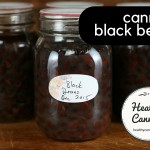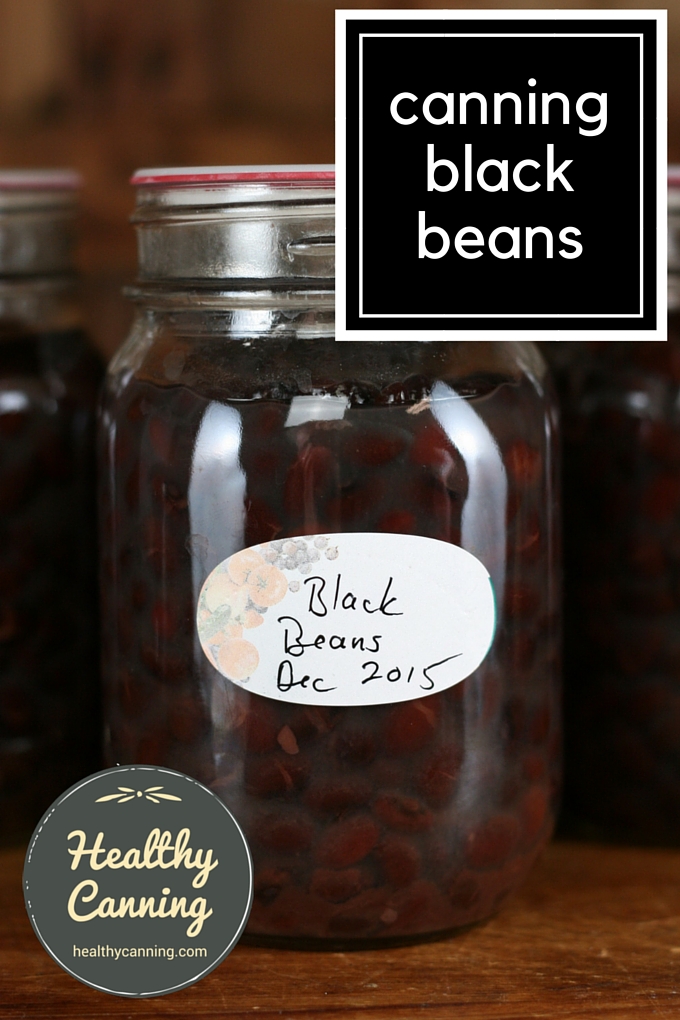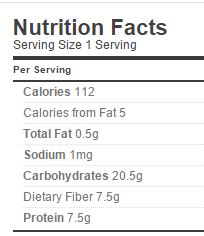Home canned black beans (aka turtle beans) have a delicious clean, nutty taste.
The home canned version also doesn’t have the tinny taste of store-canned black beans.
While it’s true that space-wise it’s best to store black beans dry, and that if you have a pressure cooker, you can have them cooked up in a few hours, the reality is that it’s still nice to have ready-to-use jars on hand, so that you don’t rush out to the store to buy tinned for quick uses, as you always inevitably end up doing otherwise.
Quantities of dried black beans needed
Numbers are approximate guidelines.
- Allow 175 g (6 oz) dried black beans per ½ litre (US pint) jar. 1.5 kg (3 lbs 6 oz) for a canner load of 9 jars;
- Allow 350 g (¾ lbs) dried black beans per litre (US quart) jar.
The recipe
Jar size choices: Quarter-litre (½ US pint) OR half-litre (1 US pint) OR 1 litre (1 US quart)
Processing method: Pressure canning only
Yield: varies
Headspace: 3 cm (1 inch)
Processing pressure: 10 lbs (69 kPa) weighted gauge, 11 lbs (76 kpa) dial gauge (adjust pressure for your altitude when over 300 metres / 1000 feet)
Processing time: Quarter-litres (½ US pint) and half-litres (pints) 75 minutes; litres (quarts) 90 minutes

Canning black beans
Ingredients
- black beans (dried. Aka turtle beans)
- water
Instructions
- Either (a) long-soak the dried black beans overnight covered with water, OR (b) quick-soak by covering them with water in a saucepan, bring to a boil, boil 2 minutes and let stand for an hour.
- However the beans were soaked, drain and discard the soaking water.
- Put in a pot, cover with fresh water, boil 30 minutes.
- Pack in jars: quarter-litre (½ US pint) or half-litre (1 US pint) or 1 litre (US quart)
- Leave 3 cm (1 inch) headspace.
- Top up each jar with clean boiling water (such as from a kettle, for instance) or with the water you just boiled them in, maintaining headspace.
- Debubble; adjust headspace.
- Wipe jar rims.
- Put lids on.
- Processing pressure: 10 lbs (69 kPa) weighted gauge, 11 lbs (76 kpa) dial gauge (adjust pressure for your altitude when over 300 metres / 1000 feet)
- Processing time: quarter-litre (½ US pint) 75 minutes; half-litre (1 US pint) 75 minutes; 1 litre (US quart) 90 minutes.
Nutrition
Processing guidelines below are for weighted-gauge pressure canner. See also if applicable: Dial-gauge pressures.
| Jar Size | Time | 0 to 300 m (0 - 1000 feet) pressure | Above 300 m (1000 ft) pressure | |
|---|---|---|---|---|
| ¼ litre (½ US pint) | 75 mins | 10 lbs | 15 lbs | |
| ½ litre (1 US pint) | 75 mins | 10 lbs | 15 lbs | |
| 1 litre (1 US quart) | 90 mins | 10 lbs | 15 lbs |
Reference information
How to pressure can.
When pressure canning, you must adjust the pressure for your altitude.
More information about Salt-Free Canning in general.
Recipe notes
- The USDA guidelines don’t mention the smaller quarter-litre (½ US pint) size jar, but it’s fine to do so, and it’s really handy to have that 1 cup size for garnishes, salads, etc. It just has to have the same processing time as the next tested size up.
- The beans must be partially rehydrated by the methods described before going into the jars. It is not safe to put dried beans in a jar and fill with water, nor will the quality of the product be good either.
Recipe source
Beans or Peas – Shelled, Dried: All Varieties. In: United States Department of Agriculture (USDA). Complete guide to home canning. Agriculture information bulletin No. 539. 2015. Page 4-5.
Modifications: none
Nutrition
Per ½ cup (115 g):
- 112 calories, 1 mg sodium
- Weight Watchers PointsPlus®: 3 points; 1 cup / 225 g = 5 points
* Nutrition info provided by https://caloriecount.about.com
* PointsPlus™ calculated by healthycanning.com. Not endorsed by Weight Watchers® International, Inc, which is the owner of the PointsPlus® registered trademark.



David Paul Koester
Trying Canning in the new Instant Pot Max…it has a canning feature and holds 15lbs of pressure. I assume that I can vent it after 75 min using pint size jars. Thanks for this information!
Healthy Canning
It is not supported for pressure canning by the USDA, the National Center for Home Food Preservation, by Ball, by Bernardin, or any of the university extension services. In terms of safety, you’re on your own.
Rachel
I’m canning beans for the first time. Is the 175 g of beans before or after soaking?
Healthy Canning
That’s dried, before soaking. Those estimates are very rough and just give rough guidelines of what to purchase. It’s very rare, though, that actual yields actually match what they would seem to promise us!
Shannon
Hi,
Do you think there’d be any issues with adding (fresh) chilis and lime juice to these when canning them? What about onion powder?
Healthy Canning
I’m deliberately avoiding the pieces of fresh chile part of the question because that moves beyond the question of just “seasoning.” I can’t see any issue safety wise with some juice juice, and a tidge of onion powder. In the long run, though, you’ll find it more flexible to have jars of just plain ones of the shelf. Seasonings such as that are the work of seconds to add upon opening. See this page on safe tweaking: https://www.healthycanning.com/safe-tweaking-of-home-canning-recipes/
Beth
I am the only one that likes black beans, chickpeas etc. Can I can them in 1/2 pint?
Healthy Canning
Yes, you may. Use the processing times for pint jars.
Terra
Question. Ok, I did the recipe filled it with 1 inch headspace, filled part bean water and the rest hot water and pressure canned. The next morning they’re all sealed but look frozen in time like they’re in a gel. Flipped it upside down and they don’t move lol. Is it because of how starchy that they create a Gel, or did I do something wrong?
Healthy Canning
When canning beans, the water often does tend to thicken. That is fine.
Beth Kenward
When you open them and dump them out they will be fine. Dry beans soak up a lot of water. I usually don’t put as many beans in as recommended because I like the to be a little floaty but they usually end up soaking up that liquid as well.
Naomi
Thank you so much for sharing information about using half pints. I’ve wanted to do this as there is only two of us now and often a pint is simply too much.
Is it safe to double stack them? Is there anything special to know about double stacking half pints?
Sincerely Naomi
Healthy Canning
Stacking in a pressure canner is fine for half-pints.
Amanda Mendez
I have been canning beans double stacked for some time with great success. I do put a rack just like in the bottom of the canner between the layers. I double stack pints which is fine if your canner has the height to fit them.
Kathy
I don’t see the water bath method – must black beans be pressure canned?
Thank you!
Healthy Canning
There is no water bath method for any low-acid foods, of which beans are one. They all require pressure canning.
Portia
Can you add citric acid or lemon juice or vinegar if your only method to can is water bath?
Healthy Canning
Pressure canning is the only option.
Amanda
You say to use 15 lbs pressure for 90 min but my presto manual says 12 lbs for 90 min at my current altitude (3500 ft)
I’ve seen lots of other recipes that say to use 15 lb also. If I did my batch yesterday at 12 lbs does that mean they’re no good??
Healthy Canning
The table given is for weighted gauge, right above that is the link for a dial-gauge table.
If you are using a dial gauge, the pressure for your 3500 feet is 12 lbs. https://www.healthycanning.com/altitude-adjustments-for-pressure-canning/
Weighted gauge doesn’t allow for the “fine-tuning”, it shoots straight from 10 lbs all the way to 15 lbs, with nothing in between.
Susie DiResta
How long can these be stored for?
Healthy Canning
Hi Susie, the experts say best before one year and that after one year, you should rotate the jars to the front of the shelf to make sure they start getting used up first before other jars. See here for a discussion of shelf life so you can understand what they say, and why: https://www.healthycanning.com/the-shelf-life-of-home-canned-goods/